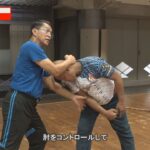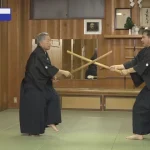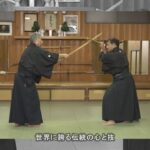The common thread between police kendo and Itto-ryu, tied to the rigors of real-world duty
Text: Satoshi Tatewaki Translation: Grigoris Miliaresis
Still living within kendo, Itto-ryu’s Kiriotoshi: The reasoning, distancing and mental aspects of the classical school’s “win –then strike” principle
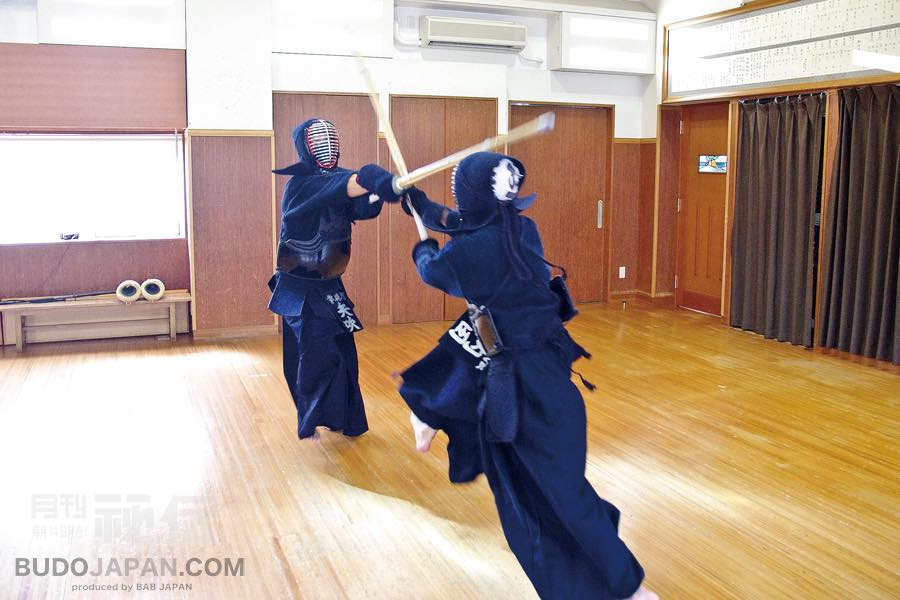
Police kendo is known for its fierceness; a fierceness that is the product of the tight bond between rigorous duty and the practical use of kendo. The teachings of Ono-ha Itto-ryu have significantly influenced this realistic kendo and in the second section of this feature, Ono-ha Itto-ryu’s 18th soke and Metropolitan Police Department’s Kendo Instruction Office instructor, shihan Yabuki Yuji expounds on the correlation between kendo and Itto-ryu’s principles, as exemplified in Kiriotoshi.
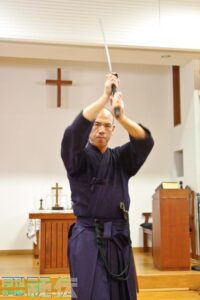 Profile Yabuki Yuji, 18th soke of Ono-ha Itto-ryu, Metropolitan Police Department’s Kendo Instruction Office instructor, kendo kyoshi 7th danYabuki Yuji, the 18th soke of Ono-ha Itto-ryu and 3rd Doshu (chairman) of Reigakudo was born in Iwaki, Fukushima Prefecture in February 2, 1970 and entered the Metropolitan Police Department in 1992. In 1993, he was designated as a candidate for the Metropolitan Police Department’s external kendo competitions. In 1995, he passed the Martial Arts’ Specialty Examination and studied kendo and Ono-ha Itto-ryu at the Metropolitan Police Department’s Martial Arts’ Specialty School. Starting in 1997 he worked successively as an assistant kendo instructor to the Kitazawa Police Station, the Police Academy, the 7th Riot Squad, and the General Education Division and in 2019 he was promoted to the position of instructor in the Kendo Instruction Office, a position he holds to this day. In 1998, he became a student of the 17th soke of Ono-ha Itto-ryu, Sasamori Takemi and on October 1, 2017, he assumed the position of the 18th soke of the school as designated by Sasamori soke. He has devoted his life to become the embodiment of the ideal of “enman” (achievement of mastery through being well-rounded) bequeathed by his predecessor.
Profile Yabuki Yuji, 18th soke of Ono-ha Itto-ryu, Metropolitan Police Department’s Kendo Instruction Office instructor, kendo kyoshi 7th danYabuki Yuji, the 18th soke of Ono-ha Itto-ryu and 3rd Doshu (chairman) of Reigakudo was born in Iwaki, Fukushima Prefecture in February 2, 1970 and entered the Metropolitan Police Department in 1992. In 1993, he was designated as a candidate for the Metropolitan Police Department’s external kendo competitions. In 1995, he passed the Martial Arts’ Specialty Examination and studied kendo and Ono-ha Itto-ryu at the Metropolitan Police Department’s Martial Arts’ Specialty School. Starting in 1997 he worked successively as an assistant kendo instructor to the Kitazawa Police Station, the Police Academy, the 7th Riot Squad, and the General Education Division and in 2019 he was promoted to the position of instructor in the Kendo Instruction Office, a position he holds to this day. In 1998, he became a student of the 17th soke of Ono-ha Itto-ryu, Sasamori Takemi and on October 1, 2017, he assumed the position of the 18th soke of the school as designated by Sasamori soke. He has devoted his life to become the embodiment of the ideal of “enman” (achievement of mastery through being well-rounded) bequeathed by his predecessor.
Police kendo and koryu kenjutsu
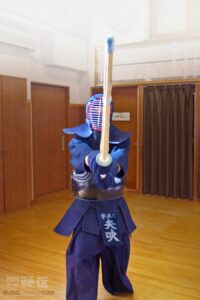 Since the Meiji Period, when the modern police force was organized, police has heavily relied on kenjutsu (kendo). With the collapse of the samurai class due to the Meiji Restoration and the 1876 Sword Abolishment Edict, kenjutsu was on the verge of decline. However, thanks to the active role the sword-bearing governmental force Battotai played the next year, 1877, in the Satsuma Rebellion, the reputation of kenjutsu was revived within the police department. Then Chief of Police Kawaji Toshiyoshi published his “Argument for the Restoration of Gekken” stating clearly his intention to promote kenjutsu in the police force. In 1879, a dojo was established in the Police Officers’ Training School, kenjutsu shihan were hired to be in charge of gekken and police became the center of kendo’s development.
Since the Meiji Period, when the modern police force was organized, police has heavily relied on kenjutsu (kendo). With the collapse of the samurai class due to the Meiji Restoration and the 1876 Sword Abolishment Edict, kenjutsu was on the verge of decline. However, thanks to the active role the sword-bearing governmental force Battotai played the next year, 1877, in the Satsuma Rebellion, the reputation of kenjutsu was revived within the police department. Then Chief of Police Kawaji Toshiyoshi published his “Argument for the Restoration of Gekken” stating clearly his intention to promote kenjutsu in the police force. In 1879, a dojo was established in the Police Officers’ Training School, kenjutsu shihan were hired to be in charge of gekken and police became the center of kendo’s development.
Even today, the police has made kendo, along with judo and arresting techniques, an important part of the education of police officers. In this interview, we had the opportunity to ask Yabuki Yuji, a distinguished member of the Kendo Special Training Squad (Tokuren) and 18th soke of Ono-ha Itto-ryu, about the relationship between police kendo and koryu kenjutsu (classical swordsmanship) and the differences and similarities between their techniques, and have him demonstrate some of them.
From Kendo Tokuren to Ono-ha Itto-ryu
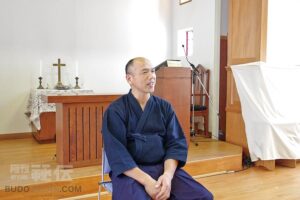
We visited Yabuki shihan at the Reigakudo, a kendo dojo with a focus in classical martial arts that was built to be at the same time a dojo and a church (Komaba Eden Church) –probably the only of its kind in the whole country!
Even among police officers, those of the Technical Division Special Training Squad (Jutsuka Tokubetsu Kunren or Tokuren) are said to belong to an extraordinary department. In the case of the Kendo Tokuren, its purpose is to focus on kendo as practiced in the Technical Division and winning matches is an important professional duty. In the future, these officers will be employed as assistant kendo instructors in police departments, a path that strong kendoka aim for in the non-professional world of kendo. However, Yabuki soke’s involvement with the Kendo Tokuren is somewhat different.
“I first came into contact with kendo when I was in the fourth grade of elementary school but I started practicing seriously in junior high school. I was a member of the kendo club until high school and won first place in the prefectural tournament but I have not participated in any other tournaments beyond that.”
After graduating from high school, Yabuki soke worked for a while in the private sector in his hometown in Fukushima; later, at the recommendation of a police official who had helped him with kendo, he ended up working as a police officer for the Metropolitan Police Department (MPD) but in a post that was somewhat apart from kendo.
“I was selected as a player in the annual kendo tournament between police departments; I happened to do well in that tournament and was awarded first place. The chief at the time ordered me to go to train at the Tokuren so I started training at the headquarters and many of the people who trained around me had been active in national-level competitions; frankly speaking, there were times I thought ‘Is it really OK for me to be here?’”
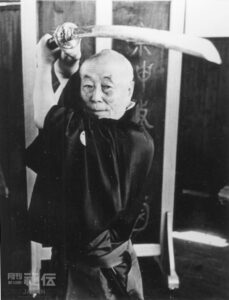
Among the students of Sasamori Junzo soke were police kendo notables including Ishida Kazuto, Ono Jussei and Ogawa Chutaro.
It was during his training in police kendo that he was also introduced to Ono-ha Itto-ryu. In order to become an assistant kendo instructor, one must be enrolled in the Martial Arts’ Specialty School and have a thorough education in kendo. Part of this curriculum was a course in Ono-ha Itto-ryu and this was his first contact with the school; he would meet its previous soke Sasamori Takemi a little later, by chance.
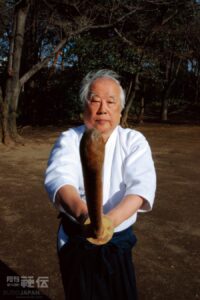
Soke Sasamori Takemi, who also taught Ono-ha Itto-ryu at the National Police Academy.
“After completing the Martial Arts Specialty School, I was transferred from the headquarters’ Tokuren and became an assistant kendo instructor at the Kitazawa Police Station. At that time, the Reigakudo dojo was going under a reconstruction and they asked if they could rent the Kitazawa Police Station kendo dojo; it was through this fortunate occasion that I met Sasamori sensei and became a student of Itto-ryu.”
As his practice in Ono-ha Itto-ryu increased, Yabuki soke felt that many of the doubts he had felt about kendo were being dispelled.
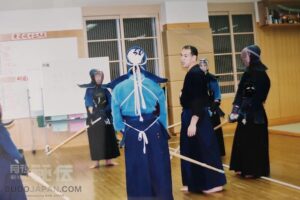
As an assistant kendo instructor, Yabuki soke taught officers and juveniles; currently he serves as a kendo instructor in the Kendo Instruction Office
“One of the reasons I joined Itto-ryu was because I was having a hard time to get my kendo to work in the headquarters’ Tokuren. Believing I had to reexamine my own kendo, I thought I would do that through the practice of Itto-ryu. The meaning of the kamae (postures), the use of omote and ura (front and back), the positioning of the sword’s tip and other things that I had wondered about until then, were resolved during practicing Itto-ryu. With the thought ‘If I pursue this, will it change my kendo?’ I continued practicing at the Reigakudo.”
The objective of police kendo
Kendo as practiced within the police force is sometimes referred to as “police kendo” (keisatsu kendo); while there aren’t any major differences from kendo as practiced by students or in corporate teams, there are some rules unique to the police e.g. that in the All-Japan Police Championships, individual competitions are one-point matches (ippon shobu) without a time limit, that during a match, foot sweeps (ashi-barai) are allowed etc.
“Police kendo practice is intense. Protecting people from criminals is an important duty when serving in the police and it is in this context that foot sweeps are allowed: they are a remnant of old-times’ grappling. In kenjutsu, when you fought a villain, you put your life at stake to cut him down; the same is true today when sometimes we need to sacrifice our life. This is the background against which we practice and this is why this practice is fierce.”
The police officers who practice at the headquarters’ Tokuren are usually engaged in martial arts training and winning competitions is an important part of their duties. However, they are assigned to the riot squad and as such, when called upon they rush to the scene; being in the front line in emergency situations, the results of their daily training are put to the test. One of the rules of police kendo that illustrates its severity is foot sweeps which, although considered a foul by regular kendo rules, are permitted in police kendo but only for the area below the ankles. When you are in really close quarters, like in a Tsuba-zeriai situation, it is a valid technique and Yabuki soke was kind enough to demonstrate for us how it is actually practiced: at the moment the two shinai are poised in Tsuba-zeriai, you sweep the opponent’s front foot while pushing the joined shinai and that makes it easy to break the opponent’s posture; if a strike is made when the opponent is falling, it is a valid point in police kendo. In prewar kendo, foot sweeps and grappling using the Men (face mask) were allowed so it looked like jujutsu techniques were part of kendo’s offense and defense –a very practical kendo indeed.
“When there is the possibility of a foot sweep you don’t go into Tsuba-zeriai carelessly. In a real sword fight where you are using real swords that will cut you the moment they touch you, it would be impossible to stay with the swords interlocked for a long time. And in police kendo, where foot sweeps are allowed, you can’t get thoughtlessly into Tsuba-zeriai because your foot will get swept the moment you engage.”
Watch your Tsuba-zeriai! Police kendo foot sweep
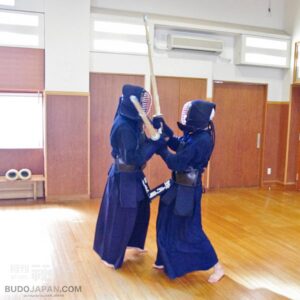
① If you get close carelessly,

② you are immediately fed a foot sweep.
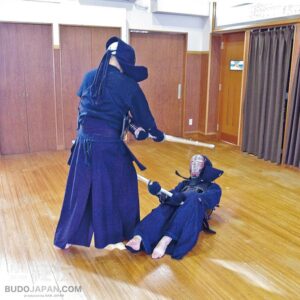
③ In police kendo tournament matches, foot sweeps below the ankles are allowed and strikes after knocking down the opponent are valid.
Sen Sen no Sen: Police kendo and Itto-ryu and the teachings about spacing common to both
The techniques of police kendo look like transitional images from the change of kenjutsu to kendo, a time when people openly fought each other using the principles and techniques of kenjutsu. Having become well versed in these principles and techniques through his Ono-ha Itto-ryu practice, soke Yabuki also explained to us the common ground between police kendo and Itto-ryu.
“In the Tokuren, I was surrounded by many first-rate players and I had many opportunities to hear them talk about kendo principles. When you are facing an opponent, the closer you get to him, the more strained and stiff your body becomes and in that state, the outcome is dependent on how much you can relax this tension. You close the distance with a spirit of abandonment, you sense the moment you can unleash your technique and from the shortest distance, you go through your opponent without stopping –all the top players I talked to, said the same thing.”
Through Sen Sen no Sen, you pressure your opponent and create a winning situation before you cross your swords; this is something that both modern kendo and classic kenjutsu Itto-ryu, think of as an important principle. At the moment the opportunity appears, you strike the opponent from the shortest distance as in modern kendo or you raise the sword and cut him down as in koryu; there are differences in the actions depending on the weapon and the circumstances, but the rationale before crossing swords is the same.
“In Itto-ryu-like kenjutsu, you raise the sword and cut down. This movement too became smaller with each change from Ono-ha Itto-ryu to Nakanishi-ha Itto-ryu and Hokushin Itto-ryu; in Hokushin Itto-ryu, the movement is closer to that of modern kendo. In both cases, you are either pressuring the opponent or are being pressured by him through Sen Sen no Sen and this difference i.e. whether you are applying the pressure or receiving it, makes the movements, the spacing and the power of the technique completely different. Although the distance might look exactly the same, the results will be different depending on whether you can win with Sen Sen no Sen or not –this is the same in both koryu kenjutsu and modern kendo, and I think it is an interesting point.”
Ono-ha Itto-ryu teachings (Suigetsu no Kurai, Yukei/Mukei no Maai, Sen Sen no Sen, Sekka no Kurai, Aiuchi no Kachi)
Habiki no Kata
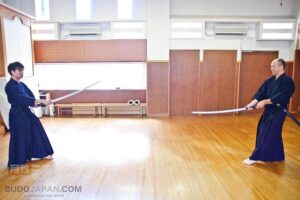
① Uchikata stands in Seigan opposite Shikata who is in Gedan.
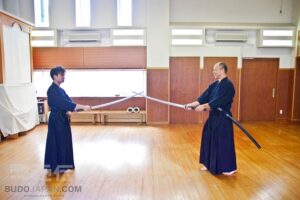
② They get to Issoku Itto no Maai, and pressuring Uchikata with Sen Sen no Sen, Shikata raises his sword.
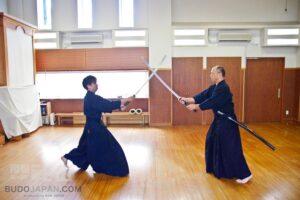
③ Under pressure, Uchikata goes to strike Kote, but
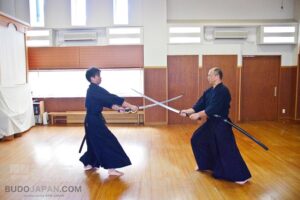
④ Shikata does Kiriotoshi and

⑤ thrusts at the Mizoochi. A similar technique is used in the Police Kendo Third Basic as “Kote-Uchi Kiriotoshi Men”.
The principles of koryu as taught by the MPD’s “Kendo Kyohon”
“Kendo Kyohon” (Kendo Instruction Manual) is a technical instruction handbook for police kendo, compiled by the MPD Police Affairs Department’s General Education Division. Its First Basic and Second Basic sections explain the techniques of kendo, but the Third Basic section is said to contain much of what is believed to be koryu techniques.
“Even in police kendo, the MPD’s Third Basic is taught to those who are at least 6th dan; important techniques from the koryu like Itto-ryu’s Kiriotoshi are taught to the people who from there on will become instructors. Every person who becomes an MPD kendo instructor studies this Third Basic and because of that, kenjutsu techniques are passed on through police kendo.”
The Kiriotoshi practiced in Ono-ha Itto-ryu, is cutting down the opponent’s sword and the opponent himself in one beat, whereas the Kiriotoshi technique taught in the MPD’s Third Basic is Kiriotoshi as it occurs in kendo’s attack and defense. Because it is difficult to perform Itto-ryu’s Kiriotoshi as it is in the flow of kendo’s attack and defense, the students are initially trained to perform the Kiriotoshi and the attack in two beats. For example, when you are being attacked at Kote or Do, you do a Kiriotoshi in a small movement and then counter-strike Men –this two-beat movement is practiced in a seamless manner, aiming to achieve a one-beat movement. In Itto-ryu, this is called “Sekka no Kurai” (“state where a spark is born from the flint hitting the steel”) and it is taught how to be used in kendo’s attack and defense.
MPD Kendo Basics
・Third Basic, Do Kiriotoshi Men
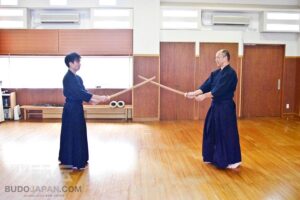
① Both start from Chudan,
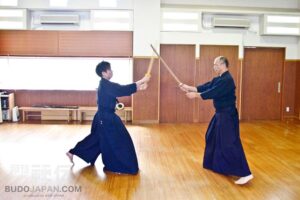
② as the opponent comes to strike Do,
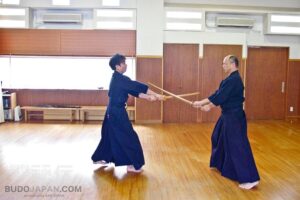
③ we do Kiriotoshi at a slight angle
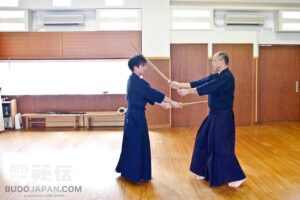
④ and strike Men.
[It is said that Saimura Goro, who created the Third Basic, was able to perform these movements, which would normally be in two beats, completely in one beat. (This is the “Sekka no Kurai” teaching.)]
When the two opponents are facing each other in Seigan kamae, their posture and distance are the same, but if there is any doubt or hesitation in their sword skills, some opening in their posture or some difference in their energy to strike will appear (this is called “Yukei/Mukei no Maai” or “tangible/intangible spacing”). This is the state of taking Sen Sen no Sen, where if before striking, there is a difference in ki between the two opponents, the one with the inferior ki will be overwhelmed by the one with the superior ki. When the two opponents strike each other while in this state, the inferior one will be one beat behind and the one who was more determined from the moment they took their kamae will strike and win through that strike. In Itto-ryu, this state is called “Cutting down after winning” and in the MPD’s Third Basic it is taught as “Source technique” (“Okori Waza”) i.e. a technique that is applied the moment the opponent starts to move, at the source of his movement.
・Third Basic, Okori Men
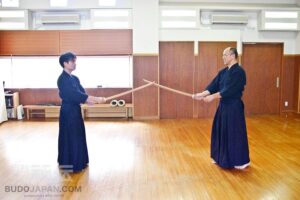
While pressuring the opponent with Sen Sen no Sen ① we control the Yukei/Mukei no Maai, perceive that the opponent will strike Men and
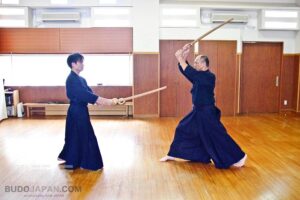
② without delay
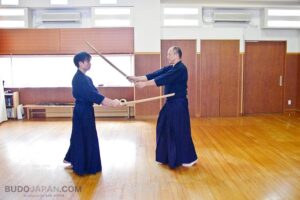
③ we strike first.
[Our technique will change depending on where we perceive the beginning of the opponent’s movement. The best is to strike responding to the beginning of the opponent’s attack, before it becomes tangible.]
Winning through Sen Sen no Sen is a prerequisite and Yabuki soke demonstrated a technique to win by Kiriotoshi from this situation against any attack, whether it is a Men, Kote, Tsuki or Do.
“Itto-ryu teaches that against any attack, you must win by Kiriotoshi” he explains. In kendo’s attacks and defenses too, no matter the opponent’s strike, if you seize it at its source, you can win by Kiriotoshi and Yabuki soke demonstrated for us that kenjutsu and kendo are based on the same principle.
・Third Basic, Okori Nodo Tsuki/Itto-ryu Mukaizuki
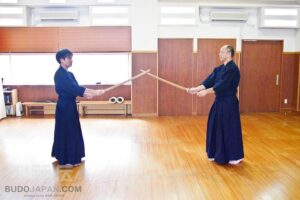
①② are the Okori Nodo Tsuki according to the MPD Kendo Basics. From the “Suigetsu no Kurai”,

the moment we perceive the beginning of the opponent’s thrusting attack we thrust first at his throat
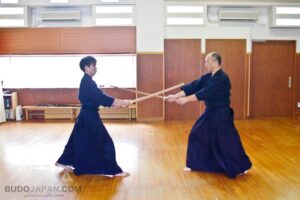
③④ are the Ono-ha Itto-ryu Nihonme Mukaizuki.

We pressure with Sen Sen no Sen, the opponent loses and goes to thrust and at that moment, doing Norizuki (riding on his tsuki) we counterattack with a thrust to his Mizoochi.
Win –then strike
“In Itto-ryu it is taught that you don’t start by applying the technique; the phrase often used is ‘win –then strike’. First and foremost, the person you must win against is your self and this truly is hard to do. How patient can you be in a situation where you are facing an opponent? How can we be not afraid and stiff but relaxed and calm? In kendo too, if you move first, the opponent will read your movement and you will get struck. The moment the opponent starts his technique, you must determine which technique you will use and defeat him at once.
“Although koryu kenjutsu is traditionally transmitted through kata, I think there is a question of whether mere repetition of the kata form is enough to convey the awareness of spacing and the mental aspects that exist within them. Kendo differs from koryu in terms of technique: through competition, kendoka train this sense for spacing and the mental aspects and I believe that these indispensable elements like the understanding of spacing, the attitude and tactics and the way to use them, we have inherited from kenjutsu. I believe that in our day and age, kenjutsu and kendo can train us in the principles and techniques of swordsmanship by complementing each other. I really believe that”.
After Yabuki soke’s demonstration of police kendo and Ono-ha Itto-ryu, we can’t help thinking that within the practical kendo for police officers prepared to devote themselves to the protection of the people, alive and well are the kenjutsu principles and techniques that were fostered through sword fights were people put their life at stake.
・Hoshato Hasso
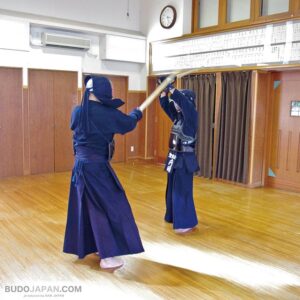
Trying an Ono-ha Itto Ryu technique in modern kendo. ① A Kote strike with a movement like that of Hoshato,
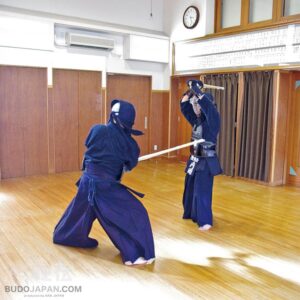
② a Gyaku Do while doing a Taisabaki to our left
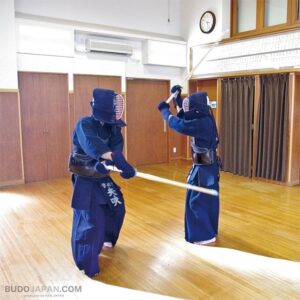
③ and subsequently, with a Taisabaki to our right, a Migi Douchi.
・Hakiriai Atarihosha
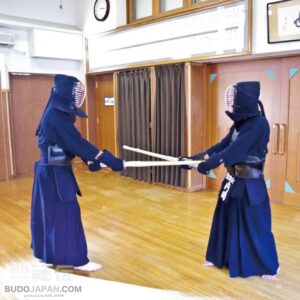
① While pushing down the opponent’s hand,
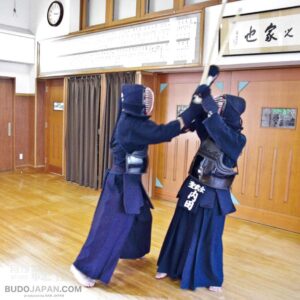
② as he tries to push up, we close the distance,
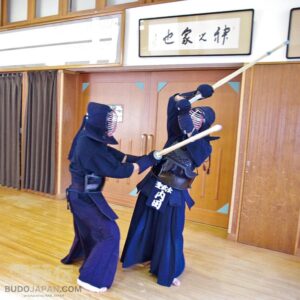
③ push him in Taiatari and do Dogiri.
・Winning with Kiriotoshi in kendo

A Kiriotoshi with the shinai from Yabuki soke. So as not to become Ukeuchi (two beats), within the flow of the movement, you do Kiriotoshi to the opponent’s shinai and in one beat strike men. One teaching of Itto-ryu is “Aiuchi no Kachi” (“winning through mutual strike”).
Related videos: VOD Takemi Sasamori Itto-ryu Gokui







